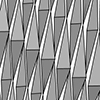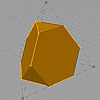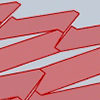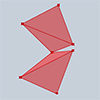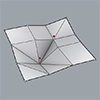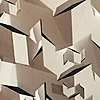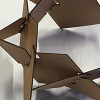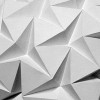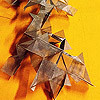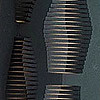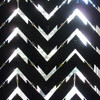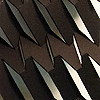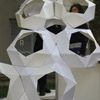This is the continuation of a very old parametric model of a building facade, presented here. I will introduce the basic Grasshopper definitions of several alternative designs. The first one is the rhombus facade. The first part of the algorithm deals with the necessary data collection. We reference a polyline from the Rhino model as the path that the facade will follow. After that, we create vertical lines around the […]
Posts with the keyword folding
While digging through the lecture archive, I found this video I made in 2017. We introduce Platonic solids and Archimedean solids in the Design Geometry course at Istanbul Bilgi University. This video shows how we can create an Archimedean solid, the Truncated Tetrahedron, by folding it from a flat sheet.While doing this, I intersected the spheres by using the relations between the side lengths of the solid, and I calculated […]
This is the continuation of the physical prototyping project of a folding pattern from 9 years ago. I simulate the folding pattern using the Rhino Grasshopper Kangaroo. As seen in the video, this is possible thanks to the pre-set hinge positions on the Rhino model. Thus, the folding motion can be animated on the screen. You can download and try the Grasshopper code. I often use this code in my […]
Here is the Grasshopper implementation of the famous Evolution Door design by Klemens Torggler. The code I used here is from my course on Parametric Modeling. This Grasshopper algorithm is a good exercise for the basics of Kangaroo. I attached several goal objects to a special mesh object created in Rhinoceros. Kangaroo’s goal objects work as expected to simulate the folding door behavior. I used the goal objects to fix […]
We will try to create collapsible structures in this new series called Folding Experiments. In this example, we will be using Grasshopper and Kangaroo components to understand the Folding Experiments: Basics first. Like other projects, this is a Parametric Modeling course exercise that usually includes primary Grasshopper usage. In our first example, we will try to fold a mesh object. To be able to fold a surface like origami, we […]
The Cut & Fold & Craft exercise is the mid-term project for last year’s Computation-based Basic Design Studio at İstanbul Bilgi University Faculty of Architecture. I really enjoyed the technique called Kirigami. Most of the projects are not flat-foldable but they are all cut from a single sheet of paper. This technique seemed a little bit limiting at the beginning, but the students managed to design very interesting compositions in […]
This project started as a study on a geometric method called quadror, but resulted in an amazing self-standing structure with the capability to fold flat. Initially, after Ayza made lots of sketches and models, the project team continued the research and finally, they managed to build one prototype only in two days. Here are some photos of this project but there are much more variations and models on their own […]
This is a project proposal designed at the workshop organized together with Simge Esin Orhun and Fulya Akipek as part of the International Wood Day Exhibition in İstanbul. This time, the final Grasshopper definition is created “after” some experiments with physical models. Here is the first model showing the idea inspired by the folding chairs studied here. I realized that in order to make a “wall” instead of a chair, it would […]
Classical folding methods were subjects to be tested and studied in this semester’s design geometry classes. This has been very useful in introducing first-year students to 3d euclidean constructions and using physical objects as references to a digital model. Groups of students studied different folding methods and made both physical and digital models. Two of these methods were dominant in the class however, one of them was the variations of Miura-Ori, […]
This year’s first semester at Basic Design Studio was full of surprises. Together with Can Sucuoğlu and Birgül Çolakoğlu, we coordinated 9 student groups in their 4-week final project called “Arboriforms“. “Arbori-” is derived from the Latin word “arbor,” meaning “tree,” and “-form” indicates a shape or form. Therefore, we can understand “arboriform” as an adjective describing something that is tree-like in appearance, structure, or form. For example, one might […]
Third and the final outcome of the Animate Patterning workshop is coordinated by Mehmet Ali. Students tried to develop a kirigami-like surface animation (which is also a good solution to my one-servo question) while they studies numerous variations. They ended up with this panel, ready to be moved by Arduino; The workshop is organized together with Mehmet Ali Altın and Fulya Akipek. Students are, Murat Akırmak, Gizem Ceyhanlıer, Cem Kıyak, […]
This is one of the works of the three-day workshop at Eskişehir Anadolu University, called “Animate Patterning“. This project is based on our previous folding experiment posted here, while students advanced it, testing a folding style called “Miura”. They built a 2.5m x 1m folding pattern, explained briefly here. After analyzing, and testing the folding technique, they drew the tessellation composed of a single parallelogram. They joined the structure together with hinges and […]
Inspired by this cut-fold pattern, we developed a prototype with Fulya Akipek. The first experiments were made from 3mm thick foamboards and they worked very well with 50×70 plates. However, when the project gets bigger and bigger, we needed to add a joint detail and use 5mm thick foamboards to achieve our goal (that is to develop a 1m by 2.5m shutter system). Then, we tried to animate its folding behavior by […]
Below is the final project of group 3 at İstanbul Bilgi University Faculty of Architecture Basic Design II Spring 2012 undergraduate studio*. First photo shows students’ efforts on generating formal variations. They studied much on this folding components and attaching them together to create surfaces. Their final surface spans nearly 2.5 meters in height. Forex is used as main material and they nailed them from faces. The different sizes, shapes […]

